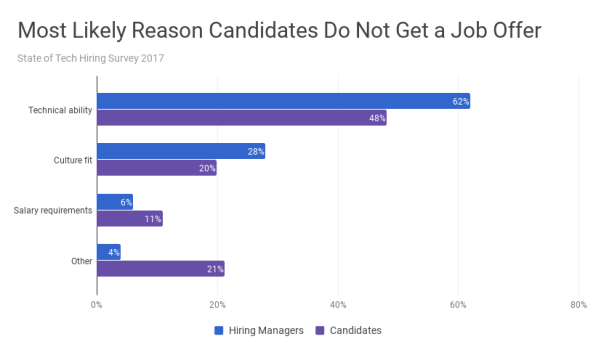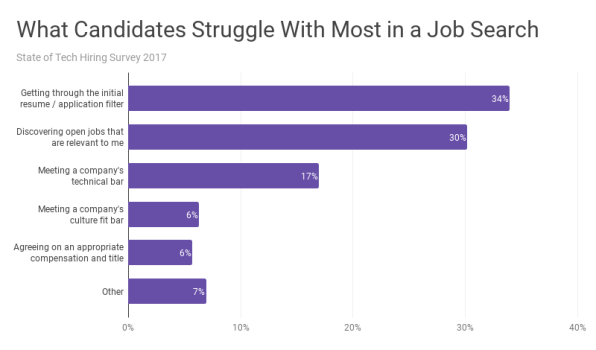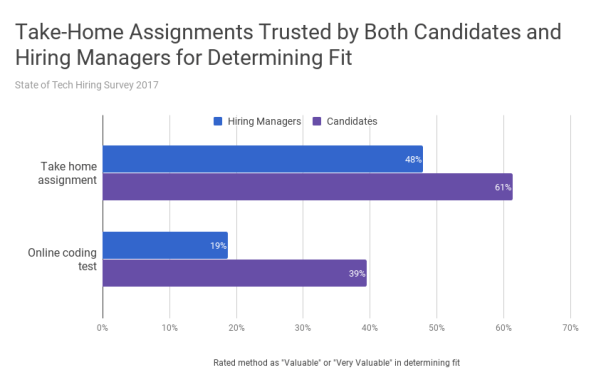A Big Reason Tech Candidates Don’t Get Job Offers? Weak Tech Skills
You’re a hiring manager, and you’ve just had budget approved to hire an engineer. So you work with recruiting to source a pool of candidates with the right experience and background, conduct phone screens with the most promising ones, and invite the best of those to meet onsite with your team. But after a long day of interviews–or several–you get everyone together to share feedback, only to find that your top candidates aren’t meeting the technical bar.
It happens more often than you may think. Last summer, I organized a global hiring study of 200 hiring managers, recruiters, engineers, designers, and product managers to understand how hiring decisions are made and job searches conducted. A key finding? Insufficient technical ability is the biggest reason for a “no-hire.”
Employers and candidates agreed that when a job offer wasn’t extended, by far the main reason was technical ability. This was followed by cultural fit, salary, and logistics of the job (location, start date, etc). In addition to these, candidates were more likely than employers to cite a bad interview experience, or to simply confess that they didn’t know what went wrong.

So despite the emphasis on culture fit and “soft skills” including emotional intelligence, this suggests that the challenge for most employers looking for tech candidates is finding those who are technically capable of doing the work. What can recruiters and hiring managers do? Here are three recommendations to try.
Cast A Wider Net
Companies need to work harder to reach qualified candidates, and that means doing more than just posting their job on their own careers pages, LinkedIn, and Glassdoor, and then asking their employees for referrals. Like their peers in the marketing department, recruiters have to think about reaching new audiences with compelling messages. These are a few good resources for sourcing tech talent that you might not be tapping into:
- Tech Ladies. Founded by a ex-Googler, this community of 20,000 women in technology offers a job board to reach women and gender non-binary professionals working in tech.
- Vettery and Underdog. Both (unaffiliated) platforms have similar models where employers can pitch candidates who are passively looking for new opportunities.
- Slack communities. Numerous public and semi-private Slack channels have popped up over the years, ranging from those for former colleagues to stay in touch, to full-fledged communities for certain kinds of professionals. Hiring managers can join these groups to connect with potential candidates and share new openings, especially since many typically have a #jobs channel explicitly for this purpose. Startuply has a great list of over 1,000 Slack communities to check out.
Allison Esposito, founder of Tech Ladies, explains that because people join communities to connect, support one another, and share resources, they’re often more trusted spaces for candidates to consider new opportunities. “I think one of the most overlooked places to post jobs is with active and existing communities,” she says. “With Tech Ladies, companies come to us to get in front of women in tech, and on the other side of things, women come to us to find companies that are thoughtful about diversity.”

Get Clear On What You’re Hiring For
The reason a candidate is rejected often has more to do with the company than the individual. And even when the reason is supposedly “technical ability,” that can mean different things at different companies. So it helps to get more specific than you think you need to be.
How detailed are the job requirements around the role? Does the CTO care more about hiring an engineer who writes solid tests, gets working code up quickly, or makes key technical and architecture decisions? And if the answer is “all of the above,” remember that when everything is a priority, nothing is.
David Osborne, a former field director for President Obama’s 2012 campaign who now runs a recruiting consultancy called Team Theory, advises companies to get clearer than they’re typically used to about what they really value within the teams they’re hiring for. “The ultimate blindspot when it comes to finding that ‘perfect fit’ is a failure in understanding that the candidate is only half of the equation,” Osborne explains. “A candidate will only be successful in working with the existing team–and if you don’t recognize your unique strengths, skills, and overall working style as a team and as humans, then you’re still just guessing about candidates.”
Osborne has found that after coaching companies to expand on and prioritize the qualities they really care about first, it gets easier to make decisions about which candidates are a good fit–and have the technical chops to help the team succeed.
Related: This Is Why Your Best Developers Keep Quitting
Update The Technical Evaluation Process
It can be tempting to filter candidates on simple criteria like previous brand-name employers or the rank of their undergraduate college, but it’s rarely as effective as employers might hope. Many top tech firms did this for years, only to learn that college, GPA, and other easy measures have no meaningful correlation with performance.
Instead, consider using work samples a core part of your evaluation process. Stanford professor Bob Sutton has argued that, looking at 85 years of personnel selection research, work sample tests are one of the highest predictors of on-the-job success. Portfolios, side projects, and GitHub repos demonstrate the kind of work that a tech candidate has actually done, meaning that those should be weighed more heavily in the hiring process.
Of course, since not everyone is in a position to share their work, introducing a take-home assignment can be a great screening equalizer, revealing how candidates tackle novel problems. This technique was rated by both candidates and employers as one of the most useful ways to determine fit for a role, far surpassing coding tests. (That finding led me to recently launch a product called Headlight, which offers a library of assessment templates, tools for managing assignments across multiple candidates, and the ability to set time limits on completing them.)

Work samples can be used in onsite interviews as well. By having candidates tackle concrete, job-related tasks, you can get a far better sense of their ability to succeed in the role. For inspiration, take a look at this list of 17 exercises WeWork uses to interview designers, including inventing a pet care product, a better way to manage waste, and designing a better news consumption experience.
It’s important to understand what gets in the way of a good match. As much as soft skills like communication and emotional intelligence are critical to performing well, our research found that a lack of technical ability for the role is even more important. By widening the net, clarifying their requirements, and improving their tech evaluation methods, employers stand a better shot at finding–and keeping–their next great hire.
Jason Shen is the author of “The State of Tech Hiring Survey” and the cofounder of Headlight, a talent assessment platform. He is completing a residency at TED and previously served as a Presidential Innovation Fellow under the Obama Administration. Follow him on Twitter at @jasonshen.
Fast Company , Read Full Story
(38)














